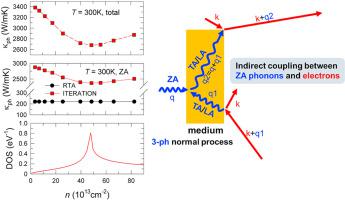当前位置:
X-MOL 学术
›
Mater. Today Phys.
›
论文详情
Our official English website, www.x-mol.net, welcomes your feedback! (Note: you will need to create a separate account there.)
Indirect electron-phonon interaction leading to significant reduction of thermal conductivity in graphene
Materials Today Physics ( IF 11.5 ) Pub Date : 2020-11-01 , DOI: 10.1016/j.mtphys.2020.100315 X. Yang , A. Jena , F. Meng , S. Wen , J. Ma , X. Li , W. Li
Materials Today Physics ( IF 11.5 ) Pub Date : 2020-11-01 , DOI: 10.1016/j.mtphys.2020.100315 X. Yang , A. Jena , F. Meng , S. Wen , J. Ma , X. Li , W. Li

|
Abstract We investigate the effect of electron-phonon interaction (EPI) on the lattice thermal conductivity κ ph of graphene from first-principles calculations. By employing an iterative solution of Boltzmann transport equation (BTE), we highlight the marked effect of the indirect coupling between the flexural acoustic (ZA) phonons and electrons on the thermal conductivity in graphene. Although the ZA phonons, the dominant carriers of κ ph , do not interact with electrons directly due to the reflection symmetry with respect to the basal plane, their anharmonic interactions with the in-plane transverse acoustic (TA) and longitudinal acoustic (LA) phonons that can be effectively scattered by electrons have a significant effect on κ ph . This is originated from the dominance of normal processes over Umklapp processes in graphene. Specifically, this indirect effect can result in up to 21% reduction of κ ph even at room temperature, and 32 % reduction in κ ph at 200 K. Moreover, κ ph does not decrease monotonically with increasing charge carrier density n. Instead, κ ph is minimized at ∼ 4.9 × 10 14 cm − 2 . This unusual finding is found to be strongly correlated with the electron density of states at corresponding Fermi levels. This indirect effect should also exist widely in other materials, whose intrinsic lattice thermal conductivities are dominated by normal processes. On the other hand, we also explore the electronic thermal conductivity κ e varying with n. Intriguingly, at room temperature κ e starts increasing dramatically at n = 4.9 × 10 14 cm − 2 , where the corresponding Bloch-Gruneisen transition temperature Θ BG exceeds the room temperature.
中文翻译:

间接电子-声子相互作用导致石墨烯热导率显着降低
摘要 我们通过第一性原理计算研究了电子-声子相互作用 (EPI) 对石墨烯晶格热导率 κ ph 的影响。通过采用玻尔兹曼传输方程 (BTE) 的迭代求解,我们强调了弯曲声学 (ZA) 声子和电子之间的间接耦合对石墨烯热导率的显着影响。尽管 ZA 声子是 κ ph 的主要载流子,但由于相对于基面的反射对称性而不直接与电子相互作用,但它们与面内横向声学 (TA) 和纵向声学 (LA) 声子的非谐相互作用可以被电子有效散射的对 κ ph 有显着影响。这源于石墨烯中正常过程相对于 Umklapp 过程的优势。具体来说,即使在室温下,这种间接效应也可以导致 κ ph 降低多达 21%,在 200 K 时 κ ph 降低 32%。此外,κ ph 不会随着电荷载流子密度 n 的增加而单调降低。相反,κ ph 最小化为∼ 4.9 × 10 14 cm - 2 。发现这一不寻常的发现与相应费米能级的电子态密度密切相关。这种间接效应也应该广泛存在于其他材料中,其固有晶格热导率受正常工艺支配。另一方面,我们还探索了随 n 变化的电子热导率 κ e。有趣的是,在室温下,κ e 在 n = 4.9 × 10 14 cm - 2 处开始急剧增加,其中相应的 Bloch-Gruneisen 转变温度 Θ BG 超过了室温。
更新日期:2020-11-01
中文翻译:

间接电子-声子相互作用导致石墨烯热导率显着降低
摘要 我们通过第一性原理计算研究了电子-声子相互作用 (EPI) 对石墨烯晶格热导率 κ ph 的影响。通过采用玻尔兹曼传输方程 (BTE) 的迭代求解,我们强调了弯曲声学 (ZA) 声子和电子之间的间接耦合对石墨烯热导率的显着影响。尽管 ZA 声子是 κ ph 的主要载流子,但由于相对于基面的反射对称性而不直接与电子相互作用,但它们与面内横向声学 (TA) 和纵向声学 (LA) 声子的非谐相互作用可以被电子有效散射的对 κ ph 有显着影响。这源于石墨烯中正常过程相对于 Umklapp 过程的优势。具体来说,即使在室温下,这种间接效应也可以导致 κ ph 降低多达 21%,在 200 K 时 κ ph 降低 32%。此外,κ ph 不会随着电荷载流子密度 n 的增加而单调降低。相反,κ ph 最小化为∼ 4.9 × 10 14 cm - 2 。发现这一不寻常的发现与相应费米能级的电子态密度密切相关。这种间接效应也应该广泛存在于其他材料中,其固有晶格热导率受正常工艺支配。另一方面,我们还探索了随 n 变化的电子热导率 κ e。有趣的是,在室温下,κ e 在 n = 4.9 × 10 14 cm - 2 处开始急剧增加,其中相应的 Bloch-Gruneisen 转变温度 Θ BG 超过了室温。



























 京公网安备 11010802027423号
京公网安备 11010802027423号